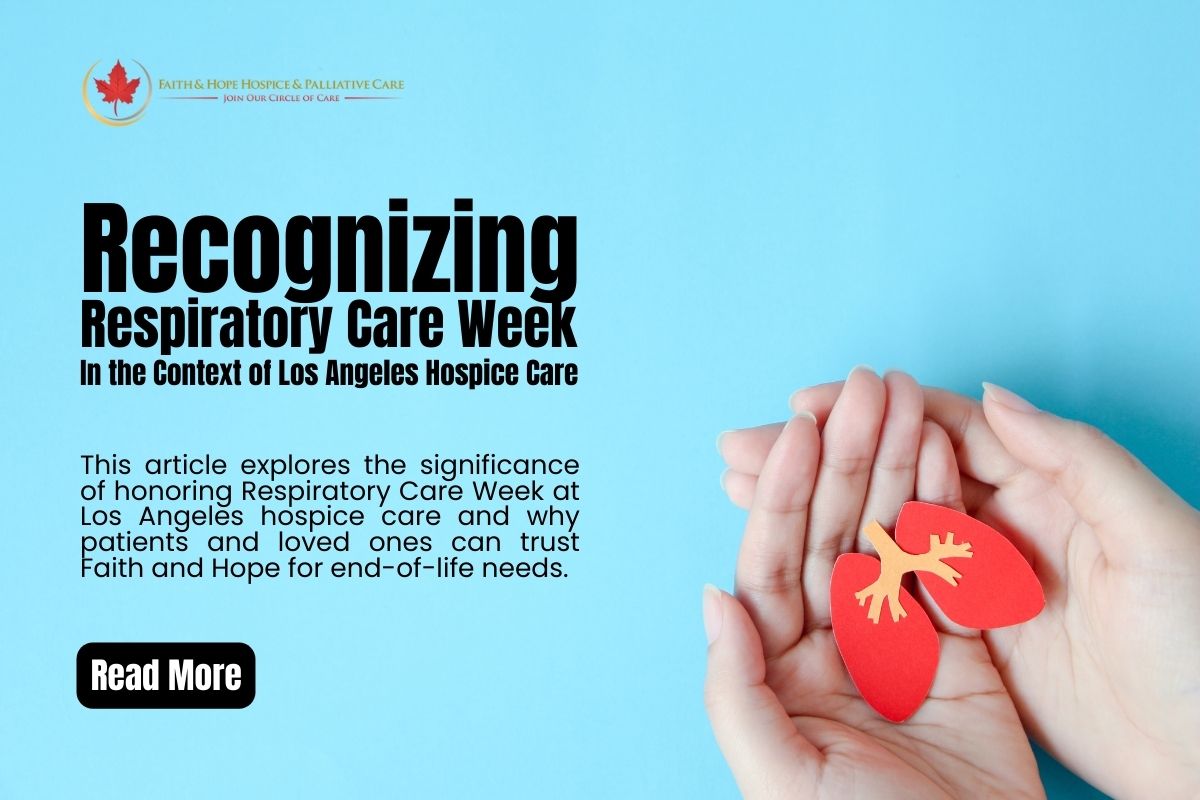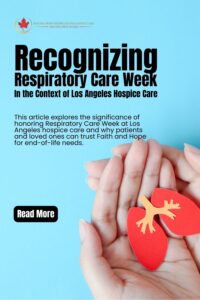
Los Angeles hospice care is a compassionate and vital component of the healthcare system that provides comfort, support, and dignity to individuals facing life-limiting illnesses. Within the intricate web of hospice services, respiratory care plays a pivotal role in ensuring patients experience the highest quality of life possible during their final stages. In Los Angeles, a city known for its diverse population and world-class healthcare agencies, Faith and Hope Hospice stands out as a trusted provider of hospice care. As we recognize Respiratory Care Week, it is essential to highlight the importance of respiratory care in the context of hospice care and why patients and their loved ones can place their trust in Faith and Hope Hospice.

Respiratory care encompasses a wide range of services aimed at improving and maintaining the respiratory function of patients. In the context of hospice care, these services become even more critical. Patients with life-limiting illnesses often experience breathing difficulties, and their comfort depends on effective respiratory management.
One of the most common symptoms in hospice patients is breathlessness or dyspnea. It can be emotionally distressing for patients and their loved ones. Respiratory therapists at Faith and Hope Hospice are trained to provide immediate relief to patients experiencing breathlessness through techniques such as oxygen therapy, nebulizers, and non-pharmacological interventions like relaxation techniques and positioning.
Staff also ensure that patients have access to the necessary equipment, such as Airvo or CPAP machines, to maintain their comfort and dignity. These devices can help manage symptoms and allow patients to enjoy a higher quality of life during their final days.
In the vast landscape of hospice care providers in Los Angeles, Faith and Hope Hospice stands as a beacon of trust, compassion, and excellence. Here is why patients and their families can confidently choose our Los Angeles hospice for their end-of-life care needs.
The heart of any hospice organization is its team of professionals who deliver care with compassion and dedication. Faith and Hope Hospice takes pride in its team of skilled and empathetic healthcare providers. The professionals understand the unique needs of patients facing terminal illnesses and strive to make their journey as comfortable and peaceful as possible.
Faith and Hope Hospice embraces a holistic approach to patient care. We recognize that hospice care is not just about managing physical symptoms but also addressing emotional, psychological, and spiritual needs. Therapists work in tandem with other healthcare providers to ensure patients receive comprehensive care that encompasses their entire well-being.
Every patient is unique, and their hospice care should reflect that individuality. Faith and Hope Hospice takes the time to create personalized care plans that address the specific needs and preferences of each patient. Respiratory care is integrated into these plans, ensuring patients receive the right interventions at the right time.
Another aspect that sets Faith and Hope Hospice apart is our dedication to end-of-life education. We empower patients and their loved ones with information and resources to make informed decisions about their care.
Continuity of care is crucial in hospice settings. Faith and Hope Hospice ensures patients receive consistent care from a team of professionals who are familiar with their unique needs. This approach provides stability and comfort to patients and their families during a challenging time.
In conclusion, Respiratory Care Week is an opportunity to recognize the pivotal role of respiratory care in the context of Los Angeles hospice care. Faith and Hope Hospice, with its dedicated team, holistic approach, tailored care plans, education initiatives, and commitment to continuity of care, stands as a trusted provider in the city’s hospice landscape. Patients and their loved ones can place their trust in Faith and Hope Hospice, knowing that they will receive compassionate and comprehensive care, including exceptional respiratory care, during their end-of-life journey.
Faith and Hope Hospice
We firmly believe that the internet should be available and accessible to anyone, and are committed to providing a website that is accessible to the widest possible audience, regardless of circumstance and ability.
To fulfill this, we aim to adhere as strictly as possible to the World Wide Web Consortium’s (W3C) Web Content Accessibility Guidelines 2.1 (WCAG 2.1) at the AA level. These guidelines explain how to make web content accessible to people with a wide array of disabilities. Complying with those guidelines helps us ensure that the website is accessible to all people: blind people, people with motor impairments, visual impairment, cognitive disabilities, and more.
This website utilizes various technologies that are meant to make it as accessible as possible at all times. We utilize an accessibility interface that allows persons with specific disabilities to adjust the website’s UI (user interface) and design it to their personal needs.
Additionally, the website utilizes an AI-based application that runs in the background and optimizes its accessibility level constantly. This application remediates the website’s HTML, adapts Its functionality and behavior for screen-readers used by the blind users, and for keyboard functions used by individuals with motor impairments.
If you’ve found a malfunction or have ideas for improvement, we’ll be happy to hear from you. You can reach out to the website’s operators by using the following email
Our website implements the ARIA attributes (Accessible Rich Internet Applications) technique, alongside various different behavioral changes, to ensure blind users visiting with screen-readers are able to read, comprehend, and enjoy the website’s functions. As soon as a user with a screen-reader enters your site, they immediately receive a prompt to enter the Screen-Reader Profile so they can browse and operate your site effectively. Here’s how our website covers some of the most important screen-reader requirements, alongside console screenshots of code examples:
Screen-reader optimization: we run a background process that learns the website’s components from top to bottom, to ensure ongoing compliance even when updating the website. In this process, we provide screen-readers with meaningful data using the ARIA set of attributes. For example, we provide accurate form labels; descriptions for actionable icons (social media icons, search icons, cart icons, etc.); validation guidance for form inputs; element roles such as buttons, menus, modal dialogues (popups), and others. Additionally, the background process scans all the website’s images and provides an accurate and meaningful image-object-recognition-based description as an ALT (alternate text) tag for images that are not described. It will also extract texts that are embedded within the image, using an OCR (optical character recognition) technology. To turn on screen-reader adjustments at any time, users need only to press the Alt+1 keyboard combination. Screen-reader users also get automatic announcements to turn the Screen-reader mode on as soon as they enter the website.
These adjustments are compatible with all popular screen readers, including JAWS and NVDA.
Keyboard navigation optimization: The background process also adjusts the website’s HTML, and adds various behaviors using JavaScript code to make the website operable by the keyboard. This includes the ability to navigate the website using the Tab and Shift+Tab keys, operate dropdowns with the arrow keys, close them with Esc, trigger buttons and links using the Enter key, navigate between radio and checkbox elements using the arrow keys, and fill them in with the Spacebar or Enter key.Additionally, keyboard users will find quick-navigation and content-skip menus, available at any time by clicking Alt+1, or as the first elements of the site while navigating with the keyboard. The background process also handles triggered popups by moving the keyboard focus towards them as soon as they appear, and not allow the focus drift outside it.
Users can also use shortcuts such as “M” (menus), “H” (headings), “F” (forms), “B” (buttons), and “G” (graphics) to jump to specific elements.
We aim to support the widest array of browsers and assistive technologies as possible, so our users can choose the best fitting tools for them, with as few limitations as possible. Therefore, we have worked very hard to be able to support all major systems that comprise over 95% of the user market share including Google Chrome, Mozilla Firefox, Apple Safari, Opera and Microsoft Edge, JAWS and NVDA (screen readers).
Despite our very best efforts to allow anybody to adjust the website to their needs. There may still be pages or sections that are not fully accessible, are in the process of becoming accessible, or are lacking an adequate technological solution to make them accessible. Still, we are continually improving our accessibility, adding, updating and improving its options and features, and developing and adopting new technologies. All this is meant to reach the optimal level of accessibility, following technological advancements. For any assistance, please reach out to
